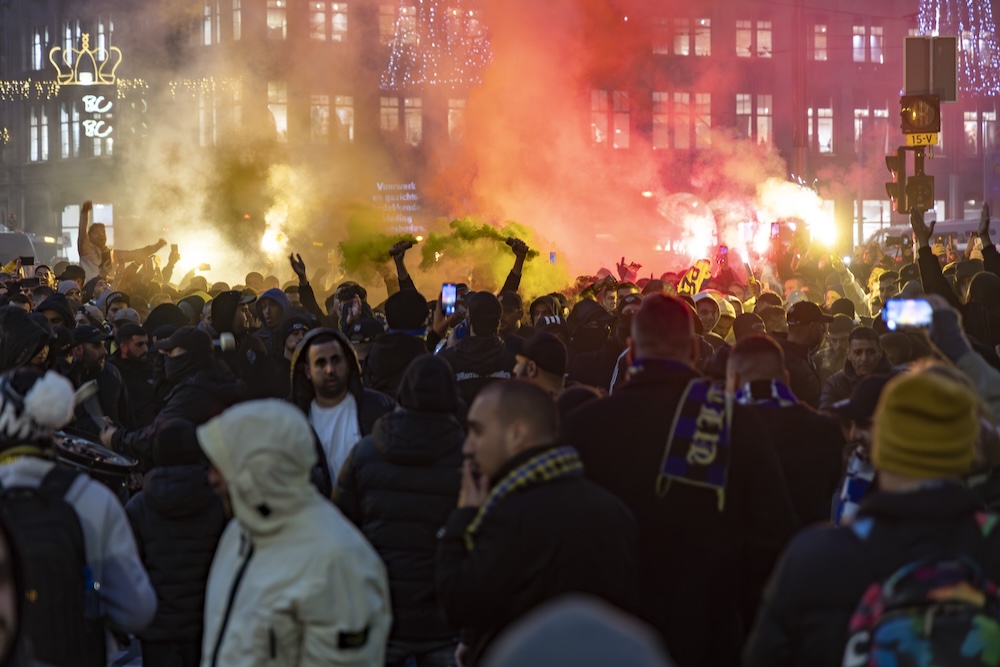- Report says social media played a key role
- Police were well organised but caught out by random attacks
- Officials and media were quick to jump to conclusions
Amsterdam police were confronted with a “fundamentally different form of violence” than they had anticipated during disturbances around last year’s Ajax-Maccabi football match last year, a new report from the justice ministry’s inspectorate has concluded.
In the report, inspectors found that while police had made thorough preparations for unrest, the role of social media gave the evenings of November 7 and 8 an unexpectedly volatile character.
“People were able to spread messages and images at lightning speed, thereby heightening existing tensions,” the report said. “In no time, this led to people coming together in groups and to confrontations on the streets. Relatively minor incidents, such as the removal of a Palestinian flag by Maccabi supporters, were shared, interpreted and magnified within minutes.”
After that incident, tensions flared between taxi drivers, often of Arab descent, and Maccabi fans. The following evening, after the match itself, further violence erupted just as the police believed they had successfully managed the large crowds and were preparing to scale back.
“The police had taken sound measures based on the usual pattern of events for this kind of match,” said chief inspector Peter Neuteboom. “What they were not prepared for were the ‘flash actions’ that took place around midnight and lasted about 90 minutes.”
These sudden, fast-moving attacks came from individuals and small groups targeting people they believed to be Maccabi supporters or Jewish. Police had expected to manage large groups of football fans and pro-Palestinian protesters, but instead were forced to respond to unpredictable bursts of violence.
The 1,200-strong police presence, including drones, mounted units, riot squads and water cannon, had to adapt quickly. “The police managed to regroup, gather Maccabi supporters, move them to safe areas and escort them to their hotels,” Neuteboom said. “This brought calm back to the city.”
On the night of the Europa League tie, five supporters of the Israeli club were taken to hospital after being attacked after the match by what Amsterdam mayor Femke Halsema then described as “hit and runs” by “youths on scooters”.
The violence caused outrage in Israel and elsewhere, with Israel at one point saying it would send over planes to rescue its citizens.
Since then, a more nuanced picture has emerged of what went on, although the police have not said how many people were attacked or how many incidents there were.
Intelligence
Monday’s report urges police to be more proactive in anticipating the potential for rapid escalation, especially due to the amplifying effect of social media. Officers had already recognised that a match between Ajax and Maccabi in a multicultural city could be sensitive, especially with tensions surrounding the Gaza conflict and the Kristallnacht memorial the previous evening.
“But again, this shows that prior intelligence does not guarantee predictability,” the report said. “Social media gave the evening its own momentum, with accusations and incitement spreading rapidly.”
The report also highlighted the “speed with which everyone expressed an opinion in the aftermath of the events.”
Conclusions
“Politicians, administrators and the media immediately jumped to conclusions, without having any insight into exactly what had occurred,” the report said. “Such judgements, expressed before the facts were known, had an influence on sentiment in society and directly affected the police officers who were on the streets.”
The events, the report said, also revealed how difficult it is to maintain order in a society in which local tensions are fuelled by global conflicts, in which digital messages can mobilise groups at lightning speed and in which expectations of the police response are varied.
“Finding the right balance between enforcement and freedom continues to be a difficult task, especially when reality evolves faster than the scenarios which were considered in advance.”
A second report, from the Institute for Security and Crisis Management, is expected later on Monday. It will assess how Amsterdam’s mayor, police and public prosecution office responded to the violence.
The public prosecution department said in March it had identified 122 different suspects, but most have not yet been named.
